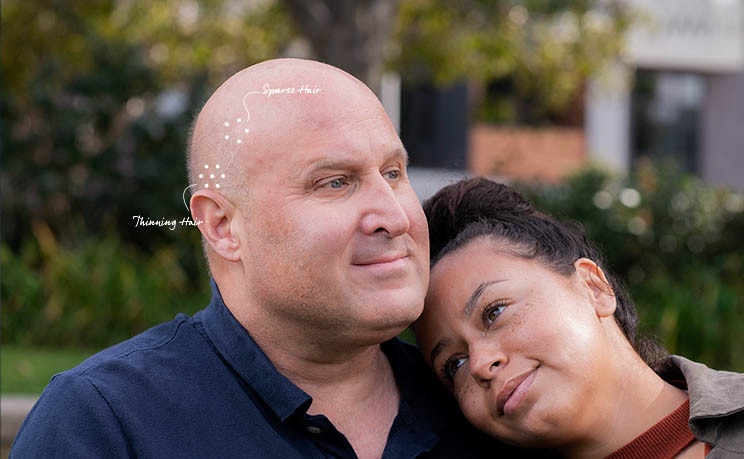AncestryDNA® Traits
Male Hair Loss
Many genetic markers can influence male pattern baldness. An AncestryDNA® Traits test can tell if people with DNA like yours may be at risk for early hair loss.
Since ancient times, people have tried to reverse male hair loss. The Egyptians wore wigs, and the Romans rubbed myrrh berries on their scalps as a hair loss treatment. Centuries later, baldness is a phenomenon that continues to fascinate humans. What about you? Is a receding hairline in your DNA? An AncestryDNA® + Traits test could help indicate if male hair loss runs in your family.


More About Male Pattern Baldness
Male pattern baldness is one of the most common types of hair loss that biological men experience. The scientific name for this condition is androgenetic alopecia. Men as young as teenagers can start to have hair loss, but it's more common in adults, especially older ones.
A receding hairline and hair thinning on the crown of the head are the typical pattern. As the hairline recedes, it makes an "M" shape on the head. Over time, the hair follicles shrink and hair eventually stops growing.
While definitely not always correlated, male pattern baldness can sometimes be linked to health problems, such as an enlarged prostate, prostate cancer, diabetes, high blood pressure, and heart disease.
The Genetics of Baldness
Scientists don't know exactly how baldness is passed down in families. But they do know environmental factors play a smaller role in male hair loss than genes. They also know male sex hormones like testosterone (called androgens) play a role, by regulating hair growth cycles.
If you look at balding genetics, you'll see it's more common to have several family members with premature male pattern baldness. So having someone in your family who has experienced early hair loss increases your risk.
Though most men don't start losing their hair until adulthood, their male pattern baldness is in their DNA from birth. Over 300 genetic markers likely influence this trait.
Science Behind Hair Loss Predictions
Predicting hair thinning and hair loss in men is tricky because so many genetic markers have been identified that influence this trait. And these markers can interact with one another, making it even more complex to determine a single specific gene’s impact.
AncestryDNA looks at over 300 DNA markers that scientists found were associated with male pattern baldness. Differences in these genes help determine how likely the test taker or their biological male relatives are to have hair loss.
One of the DNA markers associated with hair loss is found on the X chromosome. In men, this marker is inherited from their biological mom. Male hair loss was long believed to be inherited from the mother's side. But male hair loss is actually influenced by several genetic and environmental factors. Other genetic variations have been identified that prove hair loss can be passed on from both parents.
Interesting Facts About Hair Loss
Many people think male pattern baldness only affects men. But it can actually affect both genders.
Men, however, are more likely to have the condition: 50 million men in the U.S. have male pattern baldness compared to about 30 million women who have some degree of hair loss. And in men over age 50, more than half have hair loss.
Science has evolved, but even ancient Egyptians made concoctions to stop hair loss—made of fried dog paws, ground up donkey hooves, and dates.
Does your DNA suggest you (or your close male relatives) have a low or a high chance of hair loss? Find out with an AncestryDNA® + Traits test.
References
"Androgenetic alopecia." MedlinePlus. Accessed April 30, 2023. https://ghr.nlm.nih.gov/condition/androgenetic-alopecia.
Brockschmidt, FF et al. "Susceptibility Variants on Chromosome 7p21.1 Suggest HDAC9 as a New Candidate Gene for Male-pattern Baldness." British Journal of Dermatology 165, no. 6 (2011): 1293-302. doi:10.1111/j.1365-2133.2011.10708.x.
Hedgecock, Sara. "A Short History of Weird Cures for Baldness." Forbes. April 16, 2016. https://www.forbes.com/sites/sarahhedgecock/2016/04/16/a-short-history-of-weird-cures-for-baldness/#437f7110230d.
Grover, Sanjiv. "A Study of Patterns of Androgenetic Alopecia in Men: An Indian Perspective." British Journal of Dermatology 152, no. 3 (2005): 572-74. doi:10.1111/j.1365-2133.2005.06442.x.
"Male Pattern Baldness." Healthline. Accessed April 30, 2023. https://www.healthline.com/health/male-pattern-baldness.
"Male Pattern Baldness." MedlinePlus. Accessed 30 April 2023. https://medlineplus.gov/ency/article/001177.htm.
Muller, Sigfrid A. "Alopecia: Syndromes of Genetic Significance." Journal of Investigative Dermatology 60, no. 6 (1973): 475–92. doi:10.1111/1523-1747.ep12702937.
Newman, Tim. "DHT (Dihydrotestosterone): What Is DHT's Role in Male Pattern Baldness?" Medical News Today. November 26, 2015. Accessed August 3, 2016. http://www.medicalnewstoday.com/articles/68082.php.
Richards, J. Brent et al. "Male-pattern Baldness Susceptibility Locus at 20p11." Nature Genetics 40, no. 11 (2008): 1282–284. doi:10.1038/ng.255.
Setty, Laurel Raymond. "Hair Patterns of the Scalp of White and Negro Males." American Journal of Physical Anthropology 33, no. 1 (1970): 49–55. Doi:10.1002/ajpa.1330330108.
"Understanding Hair Loss: The Basics." WebMD. Accessed April 30, 2023. https://www.webmd.com/skin-problems-and-treatments/hair-loss/understanding-hair-loss-basics.